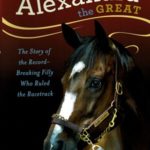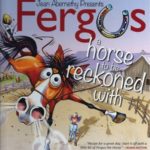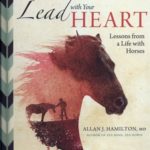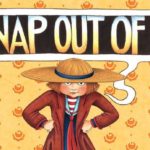Visitors to the Kentucky Horse Park are immediately drawn to the bronze statue of Man o? War, standing high on a pedestal just inside the entrance. It’s only fitting that the 20th century?s greatest Thoroughbred–and one of the greatest horses of all time?is buried in a park dedicated to horses. What most visitors don’t realize is that the park has become the final resting place of many other horses?horses of all breeds and disciplines. Some were famous, capturing the hearts of millions. Others only touched the lives of a few, but their memories live on just as brightly.

Gazing up at the Herbert Hazeltine sculpture of ?Big Red? is a good place to start an odyssey of the park?s burial sites. Man o? War was born in 1917 at August Belmont II?s Nursery Stud a few miles away. Mrs. Belmont named the leggy chestnut Man o? War because World War I was raging in Europe. When her husband enlisted the following year, the couple sold all of their yearlings. Man o? War, purchased for $5,000, went to Sam Riddle?s farm in Maryland for training. He won 20 of his 21 races, and the one loss was a fluke.
He was indeed Big Red?16.2 hands, with a stride of 28 feet (which is marked off on the path to the memorial), and he set track records that held for many years.
Man o? War stood at stud on Lexington?s Faraway Farm for 20 years, holding court for a million visitors. When he died in 1947 of a heart attack, he was interred at the farm. In the 1970s, when the Kentucky Horse Park came into being, Big Red?s remains and those of some of his great offspring were moved to the park. He is surrounded by horses like his daughter, Brushup, and her son War Admiral, who was the 1937 Triple Crown winner and Horse of the Year.
Sharing space with great horses at the Man o? War memorial is Isaac Murphy, the son of a former slave who became the greatest jockey of his day. Known for talking to his mounts rather than using whip and spurs, he won the Kentucky Derby three times. Murphy died in 1896, and became the first jockey elected to Thoroughbred racing?s Hall of Fame in 1955.
Memorial Walk of Champions
From the Man o? War Memorial, move on to the Hall of Champions, where eight living greats wait to greet you. Leading to the barn is the Memorial Walk of Champions, lined with the graves of eight-time Eclipse Award winner Forego, 1976 Kentucky Derby winner Bold Forbes, American Saddlebreds CH Imperator and CH Sky Watch, Standardbreds Rambling Willie and Cam Fella, and the American Quarter Horse Sgt. Pepper Feature. American Saddlebred CH Wild Eyed and Wicket is also buried thre, although he never lived at the park.
One of the graves at the Hall of Champions?a poignant one for many repeat visitors–is that of John Henry, who lies at the corner of the paddock where he entertained visitors for 22 years. Over the grave stands a bronze likeness of the Thoroughbred gelding who won seven Eclipse Awards, including two Horse of the Year titles?the last when he was 9 years old. Born March 19, 1975, at Golden Chance Farm in Paris, Kentucky, John Henry wowed the racing world, then retired to become a sometimes cantankerous but much loved fixture of the park. He died October 8, 2007, aged 32 ?? years.
Across from John Henry is the grave of Alysheba, topped by a statue of the 1987 Kentucky Derby winner and 1988 Horse of the Year. After standing at stud in King Abdullah’s stables in Saudi Arabia for several years, the 25-year-old stallion returned home to Lexington and the horse park in October 2008. The following March he fell in his stall, suffering a life-ending injury.
?Alysheba had just become part of the Kentucky Horse Park family last fall, and we were looking forward to having him for many years to come,? said John Nicholson, executive director of the Kentucky Horse Park. ?Discussions with Dr. Slovis at Hagyard and King Abdullah?s team, however, led us to conclude that this was the right thing to do for Alysheba, and Hagyard?s staff performed admirably in such a difficult situation. I am grateful to His Majesty for giving us the opportunity to enjoy this special horse and share him again with his many fans, and I am happy that his last days were spent here on his native soil.?
Kentucky-bred Forego, a 17.1-hand Thoroughbred gelding, ruled the track in the early 1970s. He was Horse of the Year three times, and won a record eight Eclipse Awards. He was retired from racing in 1978 and in 1981 came to live in the Hall of Champions. In 1997, at age 27, Forego was euthanized after he broke a bone in his pastern while turned out in his paddock.
Forego is buried next to Rambling Willie, an Indiana-bred Standardbred pacer who had died two years earlier. During his racing career, Willie was known as ?The Horse that God Loved? because one of his owners, Mrs. Farrington, tithed 10 percent of the horse’s winnings to her father?s church in Mansfield, Ohio. Willie won 128 races, 79 of them in under two minutes. When Mrs. Farrington?s tithe grew to more than $200,000, the story was featured on CBS?s ?60 Minutes,? and became the subject of a book, The Horse that God Loved. Perhaps there was divine intervention, because Willie was the only offspring of his sire and dam to have even a modicum of success. Retired from racing in 1983, Willie was a star in the Hall of Champions until his death at 25.
Another Kentucky-bred Thoroughbred who lived to the ripe old age of 27 in the Hall of Champions was Bold Forbes, a grandson of the great Bold Ruler. Foaled in 1973 at Eaton Farm in Lexington, the colt won two legs of the 1976 Triple Crown?the Derby and the Belmont?and finished third in the Preakness. Named Champion Three-year-old Colt that year and retired to stud, he distinguished himself as a sire of champions. Bold Forbes lived in the Hall of Champions from 1991 to 2000, when he was euthanized due to renal failure.
Standardbred star Cam Fella was laid to rest at the Hall of Champions in 2001, at the age of 22, after a battle with cancer. He had been a resident of the barn for four years, following a 13-year career at stud that produced six champions and winners of more than $86 million. But none of his offspring could match his accomplishments on the track. ?The Pacing Machine? logged 61 wins in 80 starts, with a 28-race winning streak that is still unmatched. Nor has his record of 32 consecutive 2:00 wins been broken. Cam Fella was harness racing?s Horse of the Year in the U.S. and Canada in 1982 and 1983 and is in the Hall of Fame in both countries.

Two outstanding American Saddlebreds are also buried near the Hall of Champions paddocks where they once grazed. They were once fierce rivals in the show ring. Illinois-bred CH Imperator was the World Champion Five-Gaited Gelding a record eight times and Grand Champion four times–in 1980, 1981, 1985 and 1986. He was 12 in 1986–the oldest horse to become Grand Champion. ?Perry? came to the park in 1989, where he basked in the attention, just as he had in the show ring. He died in 1997, at the age of 23, from complications of surgery.
Perry?s stablemate and former rival was the Kentucky-bred stallion CH Sky Watch, who was also Grand Champion four times?in 1982, ?83, ?84 and ?88–and won 12 world titles. ?Sky? and Perry competed against each other for the Grand Championship four times between 1982 and 1988. Born in Lexington in 1977, Sky stood at stud in California, and returned home to Kentucky in 1998 to become a resident of the Hall of Champions. He died three years later at 24.
Sgt. Pepper Feature, an American Quarter Horse, resided in the Hall of Champions from 1988 to 2003, when he died at age 25. The Texas-bred gelding won 13 stakes races, including a streak of five major stakes, and earned more than $900,000. In 1981 he was the AQHA Champion Quarter Running Three-year-old and Three-year-old Gelding. The next year he became the Champion Quarter Running Horse.
Walnut Hall Stud Cemetery, near the Breeds Barn
Before Walnut Hall Stud became a part of the Kentucky Horse Park it was a premier breeding facility for Standardbreds and a part of Walnut Hall Farm, which has produced champions for more than a century. In a shady area near the Breeds Barn is the farm?s original horse burial ground, where 11 broodmares? graves are marked with granite headstones. A larger marker bears a bronze relief of the stud?s great stallion, Rodney, who excelled on the track and in the breeding shed. He was Harness Horse of the Year in 1948 and sired 506 foals who amassed winnings of more than $12 million. Rodney?s son Speedster went on to sire Trotting Triple Crown winner Speedy Scot, who fathered Hambletonian winner Speedy Crown, one of the greatest Standardbred sires of all time.

The cemetery also contains the grave of a boxer named Hilda, the beloved pet of the farm?s owner, Mary Edwards Jenny, for nearly 15 years.
Champions? Cemetery, near the Big Barn
Ten horses are buried in the Champions? Cemetery, including the Polish-bred Arabian *Bask++, arguably the most important Arabian sire in the world. He was imported to the U.S. in 1963, when he was 8, and within six years was the leading sire of champions in the U.S. He won his Legion of Merit in four shows, the minimum allowed. When *Bask++ died in 1979 he was buried here and his great fire and beauty was captured in bronze by sculptor Ed Bogucki. The life-sized statue stands in the lobby of the International Museum of the Horse.
*Bask++?s son, Bask Elect+/, is also interred in the Champions? Cemetery. The Texas-bred colt won 28 championships and 28 first-place ribbons by the time he was 9. When he was blinded in a freak accident, his owners decided against putting him down. Within a year he had earned his Legion of Honor. Returning to the show ring, he became a force to be reckoned with in several disciplines. Bask Elect+/ sired 60 offspring, many of whom inherited his versatility and courage. When he died in 2003 at age 27 he was laid to rest near his sire.
Buried here in 1991 in a wooden casket lined with a Castleton Farm horse blanket was the renowned Standardbred pacer, Bret Hanover. He won 62 of 68 starts in his three-year racing career, including pacing?s Triple Crown in 1967. Following that victory he was retired to stud at Castleton Farm, where he remained until his death at 30.

This bucolic spot is also the final resting place of the Thoroughbred mare, Allez France, much beloved by French racing fans and revered world-wide as one of the greatest racehorses of the 20th century. The winner of eight Grade I stakes including the Prix de l?Arc de Triomphe, she was the first Thoroughbred filly to win $1 million. Retired at Lane?s End Farm in Versailles, she died in 1989.
Liberation First Star was interred here in 2006, but the American Morgan Horse stallion?s offspring are carrying on his winning ways as a harness and in-hand champion. He stood at stud in Maine until his death at 14.
The Cross-Country Course
During the World Three-Day Championships at the park in 1978 (the first time the event was held in the U.S.), Otto Ammermann of the German Silver Medal team rode a horse named Volturno. The black Oldenburg stallion had competed at eventing?s top levels for a decade, finishing first, second or third in 20 of his 27 international events. He helped the German team to silver medals in the 1976 Olympics and the 1980 Alternate Olympics before becoming Europe?s leading warmblood sire of event horses. Imported to stand at stud at Hamilton Farms in Massachusetts in 1988, he was attacked and fatally wounded while in quarantine in Virginia. Volturno is buried on a rise overlooking the famous Head of the Lake water jump, an obstacle on the 1978 cross-country course that remains a favorite of Rolex Kentucky Three-Day Event fans to this day.
A must for park visitors is a stroll on the cross-country course. It not only fosters respect for the big, solid obstacles the eventers jump with seeming ease, but also puts one in touch with The Grey Goose, whose ashes are scattered there. The Thoroughbred/Irish Sport Horse gelding belonged to American eventer Kim Walnes, who rode him in the 1984 Rolex Kentucky Three-Day Event. The Grey Goose was also the equine star of the movie Sylvester (some of which was filmed at the park).
The Steeplechase Course
At the finish line is the grave of Jay Trump, a legend in steeplechase circles and one of the greatest equine Cinderella stories of all time. A lackluster 3-year-old running in claiming races in Charles Town, West Virginia, he was bought by amateur rider Tommy Smith as a steeplechase prospect for Mrs. Mary Stephenson. Within two years the $2,000 purchase paid off as Smith and Jay Trump began winning jump races in Virginia and Maryland. The pair went into training in England in 1964 and qualified for the 1965 Grand National at Aintree, the granddaddy of all steeplechases. They went off at 100-6 odds. Only 14 of the 47 starters finished the grueling race, with Jay Trump beating the favorite by three-quarters of a length. He became the first Grand National winner bred, owned and ridden by Americans. Returning to the States, the famous gelding captured his third Maryland Hunt Cup before retiring to his owner?s Meshewa Horse Farm near Cincinnati, Ohio. Diagnosed with a twisted gut in 1988, he was humanely destroyed and buried at the park.
Draft Horse Field Cemetery
Ten horses are buried in this serene setting, including former stars of the park?s Parade of Breeds, and several gentle giants who pulled wagons loaded with visitors. One of the graves is that of I Two Step Two, an equine ?actor? in the movie Seabiscuit. He was a resident of the Breeds Barn until cancer felled him in 2005.
The Georgetown Field
The two horses at rest here served as gentle, dependable mounts in therapeutic riding programs for the Central Kentucky Riding for the Handicapped. Lannan?s Siri Superdot Chieftan, a Pony of the Americas champion fondly known as Chief, died in 2003 at the age of 35. The next year he was joined by Quarter Horse gelding, Foxy?s Win a Wolf, called Nugget.
The American Saddlebred Museum
A life-sized bronze by Patricia Crane stands above the grave of Supreme Sultan. Bred in Indiana, he is the only stallion to sire winners of the three biggest stakes in the American Saddlebred World Championships–Imperator in five-gaited, Sultan?s Starina in three-gaited, and Sultan?s Santana in fine harness competition. In 1983, after unsuccessful colic surgeries, he was euthanized and laid to rest here.
Nearby is the grave of a Saddlebred legend, Rex Peavine, who died in 1925 at James Hockaday?s farm in Richmond, Kentucky. When the farm was sold to a developer in 1999, the remains were exhumed and moved to the park.

Development also obliterated the Robert McCray farm in North Middletown, Kentucky, but the grave marker of a Saddlebred named Vendetta was salvaged and placed at the museum.
* * *
The remains of two horses serve a special purpose at the park?showing visitors the remarkable equine infrastructure. Hanover, bred and born at Runnymede Stud in Paris, Kentucky, lived only five years, 1884-1889. During that time he won 32 of 52 starts, defeating the era?s top runners, and sired a line of descendants said to have altered the course of Thoroughbred breeding in Europe. An injured foot led to Hanover?s premature death. His skeleton can be seen in the Academy of Equine Art at the park.
On display in the Equine Education Department is the skeleton of Indraff, a foundation sire of Al-Marah Arabians born in 1938. He died in 1963, but his legacy lives on in descendants who have won 134 National Championships, 135 Reserve National Championships, 983 Top Tens and four National Stallion Championships. So far.
Indraff?s influence–like that of all the horses at the park, living and dead–continues like ripples in a pond, touching the lives of humans in ways only a horse can.







